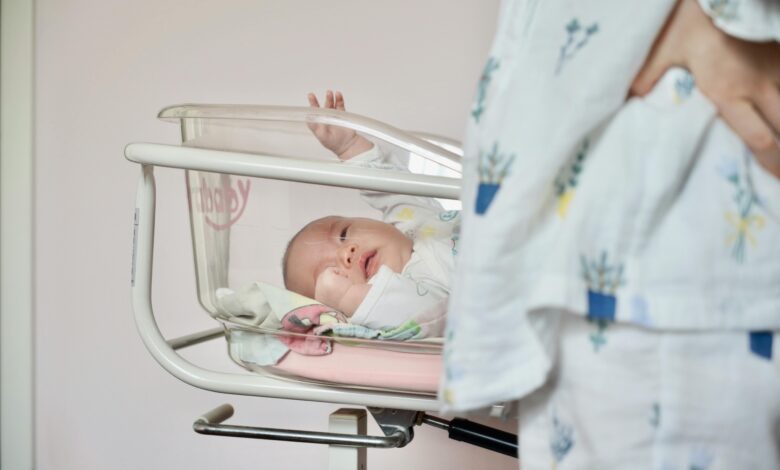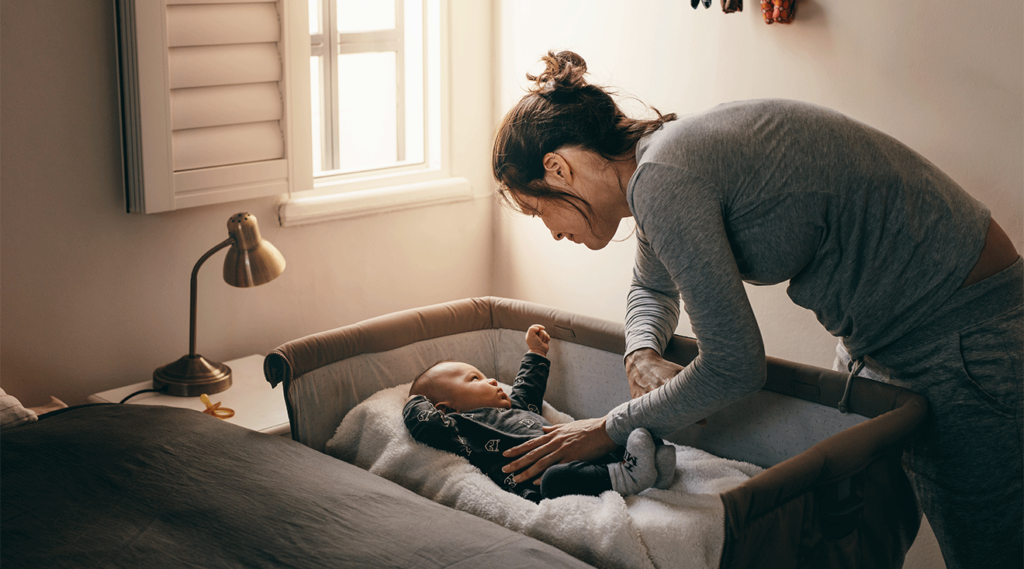
Bassinets encourage babies to sleep on their back, which helps reduce the risk of Sudden Infant Death Syndrome (SIDS). This position is also recommended by experts to prevent rolling and choking.
To help your baby sleep soundly in a bassinet, you can try creating a consistent bedtime routine and using certain strategies. Some of these tips include:
1. Place the Bassinet Near Your Bed
Keeping your infant in the same room as you while they sleep promotes bonding, encourages a healthy transition into the crib, and allows easy access to breastfeeding or nighttime feedings. However, it’s important to keep in mind that bed-sharing (a term for sleeping with your baby in the same bed) is not recommended, even if your newborn sleeps in a bassinet.
Bassinets are a safe and convenient way to ensure your newborn’s safety while they sleep in the same room as you. They are designed to help reduce the risk of SIDS by offering a comfortable sleep surface and by encouraging infants to sleep on their backs. Additionally, many bassinets feature breathable materials and mesh sides to prevent overheating and air flow problems.
To keep your baby as safe as possible, be sure that the mattress and sides of the bassinet are free of any objects or toys. Also, be sure that the bassinet is firmly secured in place. Any gaps in the frame or gaps between the mattress and the sides of the bassinet can pose a choking hazard for your infant.
2. Keep the Bassinet Clean
Keeping the bassinet clean is crucial for your baby’s safety. Wash the mattress and sheets regularly, avoiding hot water and chlorine bleach. Dry the bassinet in a cool place between uses to prevent mold and mildew. Inspect the bassinet for loose screws and connections to ensure they are secure. Store the bassinet in a dust bag and box in a cool, dry place when not in use.
Newborns are used to being snuggled by their mothers, so sleeping in a bassinet can be difficult for them at first. If your baby is having trouble falling asleep in their bassinet, try placing a soft, warm blanket near them and making sure there are no toys or other choking hazards in the bassinet.
It’s best to move your baby from the bassinet to a crib once they reach the maximum height or weight limit or start rolling over. This is typically around six months but will vary for every child. During the transition, place one of your shirts in the bassinet 30 minutes before bed or naptime to help the bedding smell familiar and comfort your baby.

3. Use White Noise or a Sound Machine
Newborns can be easily overstimulated by their surroundings and may struggle to fall asleep. White noise or a sound machine can help create a sleep space that mimics the sounds of their womb and drown out any external distractions. This is especially helpful for newborns who are used to falling asleep in a caregiver’s arms or on their chest.
For example, the SNOO bassinet has a built-in white noise machine that provides soothing sounds to help babies doze off. It also has a rocking motion that simulates the womb, which helps calm infants as they transition to sleeping independently.
Be sure to use a sound machine that is safe for newborns and plays white noise at a comfortable volume (65-75 decibels). Additionally, you can invest in a portable white noise machine, which will make it easy for baby to nap on the go! Just be sure to keep a bassinet free of toys, pillows, and loose bedding to reduce the risk of SIDS.
4. Keep the Bassinet in a Quiet Room
A bassinet can help newborns feel cozy, safe and secure in their bed because it simulates the womb. It can also be easier for new mothers to use because it doesn’t have high walls that make it difficult to lean over and pick up the baby.
While many parents enjoy the convenience of a bassinet, it is important to move your infant to a crib or regular crib at some point for safety reasons. When the time comes, try a gradual transition that starts with naps and then moves to nighttime sleep. Implement a consistent bedtime routine that includes soothing rocking and lullabies, and try to associate the crib with positive experiences, like your presence.
It is recommended that your child’s bassinet or crib be in the same room where you sleep to facilitate room sharing until they are at least 6 months old or, ideally, until one year. This allows you to monitor your child throughout the day and night and can reduce your risk of SIDS by preventing accidental suffocation and strangulation.
5. Try a Gradual Transition
Introducing your baby to their bassinet can be a stressful experience, especially if they’ve been used to sleeping in your arms or crib. Sleep expert Boys Town Pediatrics advises parents to be patient and try a gradual transition to help their newborn become comfortable in their new sleep space.
A bassinet is ideal for newborns because of its small size and close proximity to parents. However, babies are ready to move out of a bassinet around five to six months, when the risk for SIDS decreases.
To help your baby ease out of the bassinet, establish a consistent bedtime routine that includes bathing, changing into pajamas, reading a story, and cuddles. Having this ritual will help your baby understand that it’s time for bed and encourage them to fall asleep on their own. Also, make sure the bassinet only has a fitted sheet on the mattress and no other bedding. Having too many pillows, blankets, or stuffed animals can increase the risk of suffocation for your infant. Lastly, avoid putting the bassinet in a room that is too noisy or has a lot of light.




